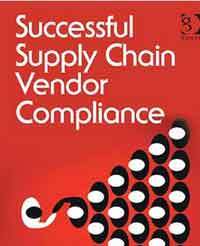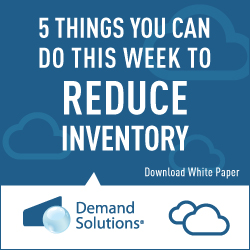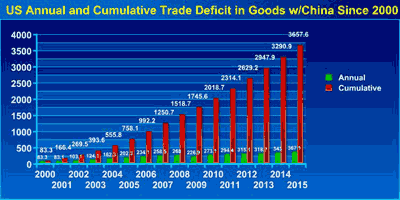|
 |
November 11, 2016 - Supply Chain Flagship Newsletter
|
|
|
|
| |
FEATURED SPONSOR: DEMAND SOLUTIONS
|
|
| |
 |
|
| |
Learn More About how to Accelerate Your Time to Value
With a SaaS Supply Chain Management Solution |
|
| |

|
|
|
 |
SUPPLY CHAIN NEWS BITES
|
US Distribution Center Real Estate Market Remains Red Hot
|
|
 |
Topsy-Turvy World of ecommerce Illustrated in Razor Market
|
 |
Rail Carriers See Strong Margins Even in Weak Q3 |
 |
China Come Down Hard on Tianjin Explosions
|
 |
How Big Can Container Ships Go? |
| |
|
|
|
|
|
|
|
The Trump Supply Chain?
Whether you saw it coming or you didn't, the intersection of supply chain and the government has likely taken a very different turn as of early Wednesday morning.
As I have done several times in the past, I am going to conjecture on what the results of this week's elections portend for supply chain. Also as previously, I am attempting to do this apolitically, aside from largely taking the general viewpoint that a healthy environment for business is a good thing.
Some context: I have lived for all but three of my years in Ohio. The Buckeye state - similar to a number of others - is littered with decent size towns that were once full of factories. Barberton (once the match making capital of the US), steel towns like Massillon, Youngstown and Lorain; and Hamilton, on the banks of the Great Miami River, a city that once produced a lot of paper - these are just a few examples. Now almost all of these towns are completely empty of such factories, or have them only as decaying hulks (hence of course the term "rust belt.")
| GILMORE SAYS: |
Is it even possible that Trump can bring the plants and the jobs back to Ohio and the rest of the country? Almost certainly not in droves - the world is a different place.
WHAT DO YOU SAY?
Send us your
Feedback here
|
I grew up near a larger town, Akron, the former "Rubber City." Unbelievable, not much more than 30 years ago, tire companies Goodyear, Firestone, General Tire and BF Goodrich were all still headquartered in Akron. Unimaginable today, due to rampant industry consolidation and other trends. Now, only Goodyear is still standing, with its world headquarters near downtown - though all the tire manufacturing that not all that long ago was still performed just south of the city core - often in multi-level factories - is long gone for places like Oklahoma and southern states.
Cleveland, Toledo, Dayton - all have also seen their economies and populations devastated by the loss of manufacturing.
So, this is context that led Ohio to go for Trump by almost 10 points, and why Midwest states Iowa, Wisconsin, Pennsylvania (the western two-thirds of which is like a Midwestern state), and Michigan did the same.
More on this later.
It seems to me the Trump election will have the greatest impact on supply chains in three areas:
Trade Policy: Obviously, a major thrust of Trump's message was against trade deals and relationships that he blames for much of the loss of US manufacturing.
I have been throughout my life mostly a "free trader." That said, the numbers are a bit eye opening. The chart below shows the annual trade deficit in goods between the US in China and the cumulative deficit since 2000.
|
|
|
As can be seen, almost every year the previous year's record deficit has been eclipsed (though that is likely to change a bit for 2016), to the tune of about $367 billion last year. Cumulatively, it adds up to nearly $4 trillion over the last 16 years. That is a lot of money by any perspective.
Is this a good situation? Maybe I am missing something, but it is hard to see how. Here is our 2015 trade deficit in goods with other select countries: Germany - $74.8 billion; Japan - $68.9 billion; Mexico - $60.6 billion; Vietnam - $30.9 billion; Hong Kong - $30.3 billion; South Korea - $28.3 billion; and India - $23.3 billion.
Then there are the good, mutually beneficial trade relationships. For example, the US had a small $15.5 billion deficit in goods with Canada, on some $576 billion in total trade between the two countries, way up from total trade of $271 billion when NAFTA was passed in 1995. With the UK, it was a small deficit of $1.8 billion on trade volumes of $114 billion. These are the "win-win" scenarios with generally free trade.
It seems certain, rightly or wrongly, that the Trans-Pacific Partnership trade agreement among the US and 11 other countries will not see approval by the Senate - though the votes were said to be there before the election.
Trump has vowed to renegotiate the NAFTA agreement between the US, Canada and Mexico, though as noted above it seems to be working just fine between the US and our Northern neighbor. There is no question much investment is going south of the border. For instance, in 2015 Kia, Audi, Toyota and Ford announced the construction of new plants in the country with a total investment of US $4 billion - and Ford upped its ante $1.6 billion more this summer. The aerospace and defense sector has also been investing heavily of late in Mexican production.
The US does not have a trade agreement with China, so there is nothing really to negotiate, other than the overall WTO framework. Good luck with that. Renegotiating NAFTA seems very problematic as well.
But trade and revitalizing manufacturing was so central to Trump's campaign and Midwest appeal that it seems certain he will have to take action. What will that mean? No one really knows. I doubt we will see 40% tariffs on goods from China, but we could see some tariff hikes in certain product areas. I also expect more actions internally and in the WTO accusing China of unfair trade practices, actions US steel and aluminum producers are now taking.
More practically, I expect there will be intense public shaming now from the White House for companies making offshoring moves - and the negative PR might just be effective for awhile.
I think almost every company needs to do some scenario planning in terms of potentially rising costs from offshored production - and consider Trump may make moves in the famous "first 100 days" of his presidency. Will such actions cause a global economic downturn, or indeed help struggling US manufacturers? Trump will have to thread a fine needle to pull this off successfully, even if he has put his finger on a real issue.
Energy and the Environment: Trump has vowed to put coal miners back to work, and further exploit the US' rising production of oil and natural gas. It is indeed the US boom in oil production in recent years that is largely responsible for the big drop in prices, as the supply-demand balanced was fundamentally changed.
But in 2015, Obama signed a UN agreement on CO2 emissions that promised a substantial level of reductions from the US. However, that agreement is non-binding, meaning a new president could largely simply ignore it.
I believe the Trump administration will also try to thread the needle here as well, strongly supporting US energy production - including coal - and scaling action from the EPA in this area substantially - while encouraging alternative energy research and development at the same time.
Regardless, there is about a zero chance of anything like a US cap and trade program for CO2 emissions for the next four years, or other government action that will force manufacturers to reduce CO2 - though many of course will continue such programs on their own. Expect energy prices to stay low.
Business Regulations: The Obama administration's love of regulating US business will almost certainly be ended, though actually reversing rules that are in place is an extremely challenging exercise. Will the new head of the US DOT keep pursuing the now suspended 34-hour restart rule, or additional changes to the Hours of Service rules generally? Likely not, as just one example.
The makeup of the National Labor Relations Board will be tilted back in business' favor. I would think a Trump administration would pull way back on the current heavy government push to have contract workers and drivers classified as employees. The regulatory state will be modestly tamed for now.
I am out of space, but is it even possible that Trump can bring the plants and the jobs back to Ohio and the rest of the country? Almost certainly not in droves - the world is different place.
But the National Association of Manufacturers has been calling for a reduction in US business taxes for years as a way to make US companies more competitive - and they are likely to get it. And the trends that have been modestly favoring US manufacturing of late - rising Chinese wages, regional manufacturing strategies - are likely to be augmented by an environment that really does support "Made in USA" both politically and commercially.
One thing is clear on a US manufacturing revival - it's now or never.
What do you think will be the biggest impacts on supply chains from a Trump presidency (please keep non-political)? Can he really help revitalize US manufacturing - or is it a lost cause? Let us know your thoughts at the Feedback section below. |

|
| |
| |
|
|
Tuesday's Videocast: |
A Bold New Paradigm for Supply Chain Planning
|

|
The Traditional Approach will Give Way to Apps, Advanced Analytics - Keep What You Have, Add in the New
In this outstanding broadcast, we will explore this new exciting paradigm for supply chain planning in detail, how it can be applied in conjunction with existing planning infrastructure, and why after almost three decades of one planning approach, we may at last be on the verge of a whole new model.
Featuring SCDigest editor Dan Gilmore and Toby Brzoznowski, executive vice president at LLamasoft.
|
 |
| Tuesday,
November 15, 2016 |
|
Thursday's Videocast: |
New Cloud WMS Solution is Game Changer for Warehouse Management Deployment and Flexibility
|
 |
New Technology and Deployment Approach Offer a Simply Better Way to WMS Implementations - Learn How
In this outstanding Videocast, we will cover the latest in each-picking robotics, co-bots, artificial intelligence, autonomous vehicles, sensors, drones and droids.
Featuring Dan Gilmore, Editor, along with Mark Hawksley and Bruno Dubreuil of TECSYS, a leading provider of WMS solutions.
|
 |
Thursday,
November 17, 2016 |
|
November Videocast: |
Successful Supply Chain Vendor Compliance - for Retailers and Beyond |

|
Author Norm Katz on Vendor Compliance "By the Book"
In this outstanding Videocast, Katz will summarize key elements of book, to include: Compliance program guiding principles; What is permissible under the law relative to vendor chargebacks; Common mistakes companies make in rolling out and maintaining vendor compliance programs; The many "E's" of successful vendor compliance, from "Envision" to "Ethics."
Featuring Dan Gilmore, Editor, Norman Katz, consultant and author of "Successful Supply Chain Vendor Compliance," and Greg Holder, CEO, Compliance Networks
|
 |
| Wednesday,
November 30, 2016 |
|
|
YOUR FEEDBACK
Just catching up on some of the many emails we received on Dan Gilmore's somewhat controversial First Thoughts column on An Inflection Point in the Consumer Goods to Retail Supply Chain?, which discussed what seems to be an emerging trend by retailers to finally address rampant supply chain variability.
A few of these feedbacks below - more next week:
|
Feedback on Reducing Retail Supply Chain Variability

Great perspective on this topic. I do however find the following statement hard to believe and would love to see more info on it: "By the way, the on-time improvement has enabled Target to reduce out of stocks at its stores by more than 50% in the past six months or so."
Mike O'Reilly
Customer Supply Chains
Perrigo
Editor's Note:
That statement was made by Target's COO during its Q2 earnings call, but more correctly was referring to on-line inventories in their DCs, not in-store OOS's.
Dan Gilmore

|
| |
| More on Reducing Retail Supply Chain Variability: |

I work in the grocery world and all of this stuff that the retailers are trying to do don't seem to have been very successful.
Walmart planning system upgrade turns out to be a giant step backwards in time.
Walmart does a lot of good things but when they make a mistakes they try to over compensate to make it work.
For Walmart, there was more stem reliability and predictability in their old planning system.
Walmart still is the best in grocery planning but they are not as good as they used to be.
Thanks for you weekly communication.
Name withheld by request
Consumer Products Company

|

Good article.
Indeed I am experiencing what you describe in your article. What you might choose to mention in the future is that there are step-function increases in supply chain cost for the manufacturer as the retailers supply chain expectations rise. Not so much from on-time being reduced from 4 days to 2 days, but when it becomes +/- 30 minutes, as some retailers already are, then additional costs are incurred by the manufacturer for special transportation services. Intermodal becomes impractical, LTL impossible and then everyone is forced into truckload or 3PL consolidators with standing appointments, milk runs with conservative transit times and lots of costs, again being paid by the manufacturer.
Ultimately the efficiency gained in one part of the supply chain is lost in another and ultimately paid for by the consumer. The bad news for the 600 lb. gorilla retailers is that they are increasingly treating their suppliers badly and the suppliers will look for alternatives such as supply chain efficiency pricing brackets, focusing on growth with better behaving retailers and various ecommerce options.
Dave Perry
Strategic Project Manager
Global Supply Chain Design & Policy
Clorox

|
SUPPLY CHAIN TRIVIA ANSWER
Q: How many manufacturing companies are there in the US?
A: 251,901 in 2014, the most recent year for which data is available from the US Census Bureau. That is actually down slightly from 256,363 in 2012.
|
© SupplyChainDigest™ 2003-2016. All Rights Reserved.
SupplyChainDigest
PO Box 714
Springboro, Ohio 45066 |
|
|




![]()

![]()

![]()










